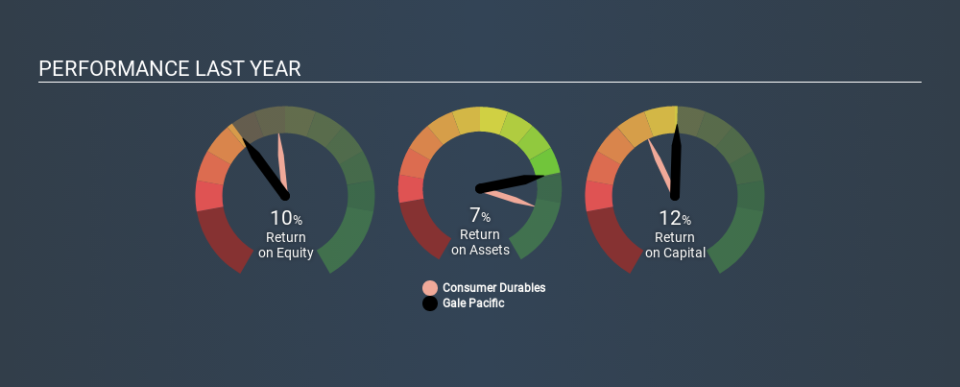Gale Pacific Limited (ASX:GAP) Might Not Be A Great Investment

Today we are going to look at Gale Pacific Limited (ASX:GAP) to see whether it might be an attractive investment prospect. In particular, we'll consider its Return On Capital Employed (ROCE), as that can give us insight into how profitably the company is able to employ capital in its business.
First up, we'll look at what ROCE is and how we calculate it. Second, we'll look at its ROCE compared to similar companies. And finally, we'll look at how its current liabilities are impacting its ROCE.
Return On Capital Employed (ROCE): What is it?
ROCE measures the 'return' (pre-tax profit) a company generates from capital employed in its business. In general, businesses with a higher ROCE are usually better quality. In brief, it is a useful tool, but it is not without drawbacks. Renowned investment researcher Michael Mauboussin has suggested that a high ROCE can indicate that 'one dollar invested in the company generates value of more than one dollar'.
So, How Do We Calculate ROCE?
The formula for calculating the return on capital employed is:
Return on Capital Employed = Earnings Before Interest and Tax (EBIT) ÷ (Total Assets - Current Liabilities)
Or for Gale Pacific:
0.12 = AU$13m ÷ (AU$155m - AU$48m) (Based on the trailing twelve months to June 2019.)
So, Gale Pacific has an ROCE of 12%.
View our latest analysis for Gale Pacific
Does Gale Pacific Have A Good ROCE?
When making comparisons between similar businesses, investors may find ROCE useful. Using our data, Gale Pacific's ROCE appears to be significantly below the 23% average in the Consumer Durables industry. This performance could be negative if sustained, as it suggests the business may underperform its industry. Separate from Gale Pacific's performance relative to its industry, its ROCE in absolute terms looks satisfactory, and it may be worth researching in more depth.
In our analysis, Gale Pacific's ROCE appears to be 12%, compared to 3 years ago, when its ROCE was 9.0%. This makes us think about whether the company has been reinvesting shrewdly. You can see in the image below how Gale Pacific's ROCE compares to its industry. Click to see more on past growth.
Remember that this metric is backwards looking - it shows what has happened in the past, and does not accurately predict the future. Companies in cyclical industries can be difficult to understand using ROCE, as returns typically look high during boom times, and low during busts. This is because ROCE only looks at one year, instead of considering returns across a whole cycle. If Gale Pacific is cyclical, it could make sense to check out this free graph of past earnings, revenue and cash flow.
Do Gale Pacific's Current Liabilities Skew Its ROCE?
Current liabilities are short term bills and invoices that need to be paid in 12 months or less. Due to the way the ROCE equation works, having large bills due in the near term can make it look as though a company has less capital employed, and thus a higher ROCE than usual. To counteract this, we check if a company has high current liabilities, relative to its total assets.
Gale Pacific has total liabilities of AU$48m and total assets of AU$155m. As a result, its current liabilities are equal to approximately 31% of its total assets. Gale Pacific has a middling amount of current liabilities, increasing its ROCE somewhat.
What We Can Learn From Gale Pacific's ROCE
While its ROCE looks good, it's worth remembering that the current liabilities are making the business look better. Gale Pacific looks strong on this analysis, but there are plenty of other companies that could be a good opportunity . Here is a free list of companies growing earnings rapidly.
I will like Gale Pacific better if I see some big insider buys. While we wait, check out this free list of growing companies with considerable, recent, insider buying.
If you spot an error that warrants correction, please contact the editor at editorial-team@simplywallst.com. This article by Simply Wall St is general in nature. It does not constitute a recommendation to buy or sell any stock, and does not take account of your objectives, or your financial situation. Simply Wall St has no position in the stocks mentioned.
We aim to bring you long-term focused research analysis driven by fundamental data. Note that our analysis may not factor in the latest price-sensitive company announcements or qualitative material. Thank you for reading.

 Yahoo Finance
Yahoo Finance 
